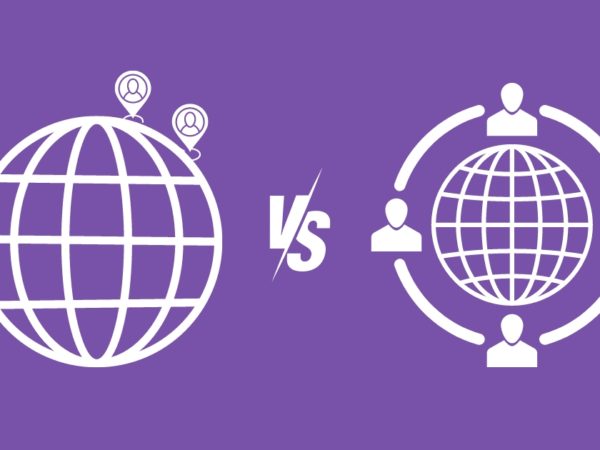<img alt="Xero vs. QuickBooks" data- data-src="https://kirelos.com/wp-content/uploads/2023/09/echo/Xero-vs.-QuickBooks.jpg/w=800" data- decoding="async" height="420" src="data:image/svg xml,” width=”800″>
Xero and QuickBooks are excellent tools to help your businesses stand out when managing accounts and finances.
Whether you are a startup, solopreneur, or small business owner, accounting is a crucial aspect of your business that you must effectively manage.
This will help you manage expenses well by tracking payments, calculating tax deductions and year-end tax, fixing salaries properly, and more.
Out of many accounting software in the market, Xero and QuickBooks are the two best online and affordable accounting software to eliminate the complexities of managing expenses and taxes.
Although both have similar goals, they are still different in many ways.
Let’s compare Xero and QuickBooks to decide which is better for your business.
Xero vs. QuickBooks: Introduction
What Is Xero?
Xero is a powerful accounting software solution that helps you do your “to-do” tasks efficiently without wasting time and effort. It is designed especially for small businesses to run things smoothly and keep online bookkeeping records.
With Xero, you can manage expenses, build bank connections, pay bills, track invoices, and more. It can automate mundane tasks like reporting and invoicing to save you effort and time.
You will get a complete picture of all the finance-related work in a single screen with up-to-date data. Xero makes end-year tax returns simple and easy and helps you execute bank feeds from your business accounts so that transactions can be securely imported into its accounting software easily. This way, all your bank transactions can easily flow into Xero automatically.
Furthermore, you will get an up-to-date picture of the cash flow with Xero. You can also use Xero to coordinate well with your bookkeepers, employees, or accountants online, no matter where you are. At the same time, you can access financial information and leave comments. This helps you discuss financial and business data with your team, which allows them to submit expenses, send invoices, and manage leave.
Xero offers various add-ons, including Xero Projects and Xero Expenses, that help you build your plan and work according to that. You can easily connect to third-party applications like Vend and Stripe to run your small business finances. It enables you to access its App Store to find, buy, and try different apps that help your business.
History:
Xero is a cloud-based accounting software based in New Zealand. In 2006, it was founded by Hamish Edwards and Rod Drury in Wellington. It has offices in Australia, New Zealand, the United States, and the United Kingdom.
What Is QuickBooks?
QuickBooks is an online accounting software solution that helps you track receipts, bank transactions, income, and more easily. You can view the whole financial picture in a single place. It can also automatically sync all your credit card and bank transactions to help you track expenses and income.
The tool makes it easier to organize and manage finance-related activities, which means less work and stress during the end-year tax time. You can snap receipts and track mileage directly using QuickBooks’ mobile application to stay compliant.
QuickBooks allows you to tag things while working to track projects, locations, events, and more. Also, you can run custom reports related to the tags to get an instant picture through the insights. With QuickBooks’ easy-to-add solutions, you can grow your business confidently.
History:
In 1983, QuickBooks was first introduced by Tom Proulx and Scott Cook in Mountain View, California, USA. It was developed and marketed by Intuit. The products are geared toward small to medium size businesses. In addition, it offers cloud-based versions for accounting needs and on-premises applications that accept payments, payroll functions, and bills. The software was popular among business owners who had no formal training in accounting.
Xero vs. QuickBooks: Features
Features of Xero
#1. Pay Bills
Xero allows you to track and pay bills faster. Also, you can get a clear view of cash flow and accounts payable. In addition, it enables you to see all the due bills for payments to stay on top of the cash flow.
Get a view of expenses, purchase orders, and unpaid bills and avoid late fees to build a good relationship with your suppliers. You can pay your suppliers in one simple transaction of multiple bills. In addition, you can schedule bill payments in advance so that you never miss anything.
Moreover, you can email bills to your files inbox using Xero for paperless records. This will help you organize and store bills and other essential documents in folders. To this, you can access documents anytime. You just need to enter the data, and the document will be shown on the screen.
#2. Claim Expenses
Xero allows you to manage expenses effortlessly. You can track costs, view spending, and quickly reimburse expense claims. All this can be easily done with Xero’s expense manager tools. Make your expenses paperless and fast from your mobile by scanning all the details from the photo receipt to auto-fill the claim.
Furthermore, you can track and maintain your mileage and also submit an expense claim in a single click by attaching a receipt. Make your work smoother by automating your expense management. To this, you can easily get notified when an expense claim is made. You can review and approve the claims quickly.
With Xero, you can pay your expenses in the same way you pay your bills. It allows your business to manage expenses using accurate views of total spending. This helps in managing cash flow and knowing when reimbursements are pending.
No matter where you are and what time it is, Xero speeds up the submission and approval of expense claims. It lets you track mileage with the help of a map in your mobile app. Just forget about paper receipts; snap a digital receipt instead.
#3. Bank Connections
Connect your business bank account to Xero and easily set up bank feeds. Allow Xero to sync all your bank feeds straight into its accounting software every business day. You can import up to one year (12 months) of data when you connect.
Daily bank feeds are complex, so Xero provides an accurate picture of the business finances. You can view a summary of incoming and outgoing money on its dashboard. In addition, Xero will categorize all the transactions every day so that there will be no pending work.
Xero builds a secure connection with your bank account so that all the data will be securely sent from the bank to Xero, enabling only Xero to access it.
#4. Accept Online Payments
You can accept online payments from customers by debit or credit card straight from the Xero invoice. Let your customers pay as they want to improve the chances of getting paid and reduce the time. Setting up payment services is easy and fast in Xero, so you can start receiving payments online.
Xero allows you to give your customers several ways to make payments. They can pay directly via Stripe, which integrates with various payment options, such as credit card, debit card, Google Pay, or Apple Pay.
Xero helps you get customized invoice templates, a business logo, a custom message, and a “Pay Now” button. It enables your customers to click straight on the button and pay fast. Data is highly protected with multiple layers of security so that online invoices are difficult to tamper with, resulting in robust security and strong encryption.
#5. Track Projects
Xero helps you quote, invoice, and get paid quickly for projects. You can keep track of payments and profitability using job tracker software. You will get a location or timer-based tracking solution to manage your costs. Xero Projects lets you set up your project in minutes and helps you allocate various tasks and expenses for your project.
#6. Pay Runs
Keep your pay records online and access them from anywhere. For a small number of employees, Xero allows you to complete all pay runs and run employee payroll reports.
Furthermore, you can pay your employees manually or through batch payments. If you want to experience a robust payroll solution, integrate Xero with third-party applications.
Other Features of Xero:
- Bank reconciliation: Keep your financials and account balances up-to-date with Xero. It enables you to confirm confidently that all the transactions in your accounts are recorded in the business financial records.
- Manage Xero contacts: You can use Xero to manage your contacts. In addition, you can view customer’s sales, payments, invoices, supplier’s sales, and more in a single place.
- Capture data: Get copies of key data and documents stored in Xero with the help of Hubdoc.
- Files: Xero is useful for storing files online. This helps you manage contracts, bills, receipts, and documents safely.
- Reporting: You can track your finances using precise accounting reports and collaborate with advisors in real-time.
- Inventory: Xero lets you track stock levels where you can populate invoices along with item orders.
- Online invoicing: Xero’s powerful invoicing software lets you work smarter. You can send online invoices, automate reminders, and do more from your desktop or mobile app.
- Multi-currency: Get paid and pay in 160 currencies using Xero’s instant currency conversions.
- Purchase orders: Create purchase orders and keep track of deliveries with ease.
- Sales tax: Calculate your sales tax automatically on transactions. You can use the reports to prepare tax returns.
- Analytics: You can track metrics, check financial health, and see cash flow.
- Accounting dashboard: Keep track of finances using the dashboard and maintain invoices, bills, bank balances, etc.
- Manage fixed assets: You can track fixed assets and manage them, letting you view up-to-date books.
- Integrate apps: Choose from different integrations, financial services, and applications to run your business better.
Features of QuickBooks
#1. Job Costings
<img alt="YouTube video" data-pin-nopin="true" data-src="https://kirelos.com/wp-content/uploads/2023/09/echo/maxresdefault.jpg64f1b43fbfd58.jpg" height="720" nopin="nopin" src="data:image/svg xml,” width=”1280″>
Keep a record of project costs with QuickBooks Online. Its clear reports and dashboards allow you to check if your revenue exceeds the project costs. You will get instant insights on profits with automatic update functionality when you start using QuickBooks Time and QuickBooks Payroll. This will enable you to make smarter decisions to maximize your profit.
#2. Inventory
QuickBooks Online lets you track inventory with real-time reports and updates. As your work goes on, quantities are automatically updated so that you always know what your present stock is to prevent shortages. Get an instant alert when there is a need for reordering. You can also access reports to see the best sellers, total taxes, and total sales.
#3. Manage Bills
Organize and manage your business bills in a single place. Get the details of the bills from the bills dashboard to know what you owe, from whom, and when to pay. You can pay partially or fully and let QuickBooks automatically track the amount you paid and update the billing dashboard accordingly.
#4. Track Expenses
You can track business expenses easily with QuickBooks to always know where the money is going. Once you connect QuickBooks to your credit cards, bank accounts, PayPal, Square, and more, it will import your expenses and categorize them for you. You can save photos of the receipts using the mobile app and stay updated to never miss any tax deductions.
#5. Manage Contractors
<img alt="YouTube video" data-pin-nopin="true" data-src="https://kirelos.com/wp-content/uploads/2023/09/echo/maxresdefault.jpg64f1b43fc6240.jpg" height="720" nopin="nopin" src="data:image/svg xml,” width=”1280″>
You can file, send, and track 1099 forms for your contractors. You need to understand the difference between W2 and 1099. While paying an amount to the contractor, you will need to track this on a 1099. QuickBooks also tracks separate expenses like paying a vendor or contractor for equipment rentals.
Other features of QuickBooks:
- Reporting: With the help of business reporting, you can track where your business stands today and figure out how to enhance it.
- Track miles: Whether you are working part-time, occasionally making deliveries, or full-time, tracking miles is useful in deducting taxes for small businesses.
- Sales tax: QuickBooks tracks all the tax laws, so you do not have to worry about tax calculations.
- Invoicing: You can create and share professional invoices and get faster payments.
- Tax deductions: QuickBooks tracks taxes and calculates the deductions for you.
- Estimates: With QuickBooks, you can easily create estimates and give your customers complete information.
- Mobile app: You can run and manage your business accounts from your mobile using QuickBooks mobile application.
Xero vs. QuickBooks: Use Cases
Use Cases of Xero
- Construction: Check the numbers and manage cash flow easily using Xero. The construction industry can stay tax-compliant with the help of Xero’s accounting software.
- Trade: From onsite trading to in-office, you can easily send invoices and quotes, manage jobs, and track expenses with a single click of a button.
- Manufacturing: The manufacturing industry can keep track of assets and stay on top of cash flow using Xero’s accounting software.
- Real estate: View client records and track performance on the go. In addition, you can manage taxes for real estate agents using this software.
Use Cases of QuickBooks
- Non-profits: Non-profit organizations can do their expense sorting, budget tracking, capacity expansion, and protection increasing with QuickBooks. You can collect and manage donations easily.
- Manufacturing: Automate a wide range of inventory processes and get clear visibility across your business with QuickBooks. You can keep costs down, make high profits, find efficiencies, and streamline order management.
- Construction: QuickBooks offers job cost tracking and flexibility you need to work from anywhere. It helps you capture all costs, manage the workforce, pay workers, and get business insights.
- Wholesale distribution: Manage your purchase, distribution, sales, inventory, and accounting from a single platform. You can protect the profit margins, centralize all information, automate inventory management, and streamline order management.
Xero vs. QuickBooks: Summary
| Xero | QuickBooks |
| Xero is an accounting software that can help you manage invoicing, inventory management, expense management, project management, bill payment, and more. | QuickBooks is a browser-based accounting application that has extensive invoicing and reporting functions along with an intuitive interface. |
| Xero is better for growing startups. | QuickBooks is better for small and medium businesses looking for advanced reporting. |
| It has a simple layout that includes easy-to-use tools and a customizable dashboard. | It has a learning curve but includes similar tools and functions. |
| Xero can be integrated with over 1000 applications. | QuickBooks can be integrated with over 750 applications and offers in-house bookkeeping. |
| It includes time-tracking capabilities in its highest plan. | It includes time-tracking capabilities from the basic to advanced plans. |
| You can access all features for 30 days without paying anything. | QuickBooks offers a 30-day free trial so that you can know which plan to choose. |
| The starter plan is $25/month. | The starter plan is $15/month. |
Conclusion
Xero and QuickBooks are amazing accounting software for growing small and medium businesses. Each has a wide range of functionalities and offerings to help you manage expenses, monitor financial health, pay taxes, and more.
In short, Xero is better for startups and growing businesses requiring a scalable accounting solution for their business. But QuickBooks is better for small and medium businesses that require inventory tracking and advanced reporting features.
Thus, choose one among them based on your business needs.
Next, check out the detailed article on NetSuite vs. QuickBooks.



